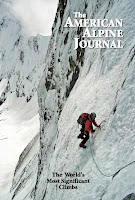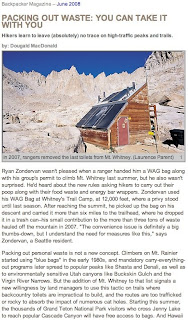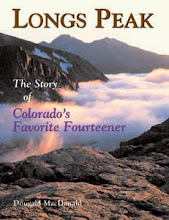 Where is the "epicenter of rock climbing in the United States?" Yosemite Valley? Boulder, Colorado? Smith Rock in Oregon? Nope, it's Dallas, Texas, according to a story in yesterday's Carrollton Leader. Before you choke on your chimichanga, read on. The paper had interviewed Kyle Clinkscales, coach of Team Texas, a competition climbing team based at the Exposure Rock Climbing Gym in Carrollton, a Dallas suburb. Team Texas has won the team title at the U.S. youth nationals for the five of the last six years; eight team members will be traveling to the Youth World Championship in Australia in August, the paper said. So, sure enough, the Dallas area is a serious center of rock climbing achievement, if you count plastic holds as "rock."
Where is the "epicenter of rock climbing in the United States?" Yosemite Valley? Boulder, Colorado? Smith Rock in Oregon? Nope, it's Dallas, Texas, according to a story in yesterday's Carrollton Leader. Before you choke on your chimichanga, read on. The paper had interviewed Kyle Clinkscales, coach of Team Texas, a competition climbing team based at the Exposure Rock Climbing Gym in Carrollton, a Dallas suburb. Team Texas has won the team title at the U.S. youth nationals for the five of the last six years; eight team members will be traveling to the Youth World Championship in Australia in August, the paper said. So, sure enough, the Dallas area is a serious center of rock climbing achievement, if you count plastic holds as "rock."
In fact, Team Texas's 35 climbers, ranging from 9 to 19 years old, also climb real rock, despite the somewhat limited opportunities near Dallas. “We’re the only team in the country that travels and rock climbs outside," Clinkscales told the paper, with perhaps a touch of hyperbole. According to the Team Texas website, the team has logged more than 150,000 miles in road trips since 1999. They've probably even hit some of those lesser epicenters of U.S. climbing. In any case, you can't argue with success.
Thursday, July 31, 2008
Boulder No Longer Center of the Universe
Posted by
Dougald MacDonald
at
10:55 AM
0
comments
![]()
![]()
Wednesday, July 30, 2008
Master of Disaster
 A backpacker named Brian Quines has started Hiker Hell, a blog that catalogues the myriad outdoor mishaps and tragedies that make it into the news. He has no shortage of material: In the last three days, Hiker Hell has covered a man stuck under a boulder for 16 hours, a missing father and son in Ohio, a hiker rescue in Phoenix, a fallen rock climber in North Carolina, a crevasse fall in the Alps, a rock climber rescue in Australia, a rock-fall death on Mt. Hood, missing hikers found in Colorado, a hiker rescue in Alaska, and a "drunk bastard who got what he deserved when he jumped down a 30-foot waterfall and injured himself." Makes you never want to leave the house.
A backpacker named Brian Quines has started Hiker Hell, a blog that catalogues the myriad outdoor mishaps and tragedies that make it into the news. He has no shortage of material: In the last three days, Hiker Hell has covered a man stuck under a boulder for 16 hours, a missing father and son in Ohio, a hiker rescue in Phoenix, a fallen rock climber in North Carolina, a crevasse fall in the Alps, a rock climber rescue in Australia, a rock-fall death on Mt. Hood, missing hikers found in Colorado, a hiker rescue in Alaska, and a "drunk bastard who got what he deserved when he jumped down a 30-foot waterfall and injured himself." Makes you never want to leave the house.
Posted by
Dougald MacDonald
at
12:51 PM
0
comments
![]()
![]()
Friday, July 25, 2008
Friday Morning Time-Waster
A great spoof from the Onion—all too realistic.
Plight Of Missing Hikers Will Make Great Movie
Tip of the hat to Pete Takeda.
Posted by
Dougald MacDonald
at
11:05 AM
0
comments
![]()
![]()
Thursday, July 24, 2008
Naming Rights
 This lovely ice pyramid in the Hindu Raj of Pakistan is the mountain formally known as Peak 5,519m, now called Somerset Ski Club Peak. It received this rather unlovely name when an Italian expedition climbed the mountain last summer and then auctioned the name to the highest bidder: the Sci Club Somerset in Turin, which paid 8,500 euros (around $13,500) for the naming rights. The money will be used to help fund a new aqueduct to supply water to the village of Ghotulti in the Chhantir Valley, not far below the newly named Somerset Ski Club Peak.
This lovely ice pyramid in the Hindu Raj of Pakistan is the mountain formally known as Peak 5,519m, now called Somerset Ski Club Peak. It received this rather unlovely name when an Italian expedition climbed the mountain last summer and then auctioned the name to the highest bidder: the Sci Club Somerset in Turin, which paid 8,500 euros (around $13,500) for the naming rights. The money will be used to help fund a new aqueduct to supply water to the village of Ghotulti in the Chhantir Valley, not far below the newly named Somerset Ski Club Peak.
Selling the names of mountains to benefit the nearby residents is all well and good. But why stop there? Here's how my quick-thinking boss, John Harlin, responded when I mentioned the naming of Somerset Ski Club Peak: "That could be a great business. Collect big bucks for naming peaks after people's deceased relatives (grieving parents should be easy pickings), companies, schools, clubs, girlfriends (Valentine's presents), chihuahuas, etc, etc. Then spend a month in Kyrgyzstan or Tibet or Yunnan collecting your 100,000 euros per year for doing what you love doing. Unfurl commemorative banners on summits, place pictures of loved ones in cairns, scatter ashes, say a poem, whatever they want. Totally cheesey, and yet a totally cool way to make a living."
Sounds good to me. I'm in.
Posted by
Dougald MacDonald
at
2:12 PM
0
comments
![]()
![]()
Wednesday, July 23, 2008
2008 AAJ Off to the Printer
 Each year I've worked on the American Alpine Journal, I've vowed that I'll get my sections done earlier—that I'll spread the enormous workload over more months. And each year I and the other editors endure an exhausting push to complete the 500-page book sometime close to our deadline. Now this year's book is finally done—late, as usual—but off to the printers at last.
Each year I've worked on the American Alpine Journal, I've vowed that I'll get my sections done earlier—that I'll spread the enormous workload over more months. And each year I and the other editors endure an exhausting push to complete the 500-page book sometime close to our deadline. Now this year's book is finally done—late, as usual—but off to the printers at last.
The AAJ is the Grade VII big wall of climbing and mountaineering publications. Although there are brief moments of excitement and even joy in producing this book, most of the process is just painstaking, seemingly endless labor. And, like those who've never done a big wall, people who haven't worked on projects similar to the AAJ can't really understand what's involved. It's just very, very difficult, in ways that surprise me each year. The sheer volume of work and the weeks of brain-frying attention to minute details are not compensated with anything like a professional salary, given the time invested. Yet I wouldn't trade this work for anything else. For one thing, I get to work with fascinating individuals from around the world—this year, in my sections of the AAJ, I worked with authors from 17 different countries. (How cool is that?) I get to collaborate with an extraordinary team of fellow editors and designers: John Harlin, Kelly Cordes, Lindsay Griffin, Steve Roper, Joe Kelsey, Adele Hammond, and Dan Gambino—a dream team. And there is a great sense of pride that comes from working on a journal that's been continuously published for 79 years and is absolutely unique in the world. Truly, it's a privilege.
Now, pour me a drink. I need one.
Posted by
Dougald MacDonald
at
3:33 PM
0
comments
![]()
![]()
Tuesday, July 22, 2008
Dropsies
 I did a nice link-up of seven pitches on Hallett Peak in Rocky Mountain National Park last weekend, but I don't have any pictures. Why? Because I dropped my camera from about 300 feet up the cliff. This is the fourth mini-digital I've lost in about three years: I dropped one in the mud along the Little Colorado River at the bottom of the Grand Canyon, left one on the roof my rental car as I drove away from Frankenstein in New Hampshire after ice climbing, had one stolen in Spain, and now dropped one off Hallett's northeast face. Years ago I dropped another camera off the Diamond on Longs Peak. The good news is that it's remarkably cheap to replace these cameras. The bad news is I'm a confirmed moron.
I did a nice link-up of seven pitches on Hallett Peak in Rocky Mountain National Park last weekend, but I don't have any pictures. Why? Because I dropped my camera from about 300 feet up the cliff. This is the fourth mini-digital I've lost in about three years: I dropped one in the mud along the Little Colorado River at the bottom of the Grand Canyon, left one on the roof my rental car as I drove away from Frankenstein in New Hampshire after ice climbing, had one stolen in Spain, and now dropped one off Hallett's northeast face. Years ago I dropped another camera off the Diamond on Longs Peak. The good news is that it's remarkably cheap to replace these cameras. The bad news is I'm a confirmed moron.
Ironically, I was experimenting with a new system for carrying my tiny camera while climbing. This new system cannot be recommended. If anyone has a great method for carrying small cameras—keeping the camera secure and out of the way while leading or following, yet quickly accessible (and secure) for shooting—I'd love to hear about it.
Posted by
Dougald MacDonald
at
7:22 AM
6
comments
![]()
![]()
Tuesday, July 08, 2008
Waste Case
Posted by
Dougald MacDonald
at
10:24 AM
5
comments
![]()
![]()








